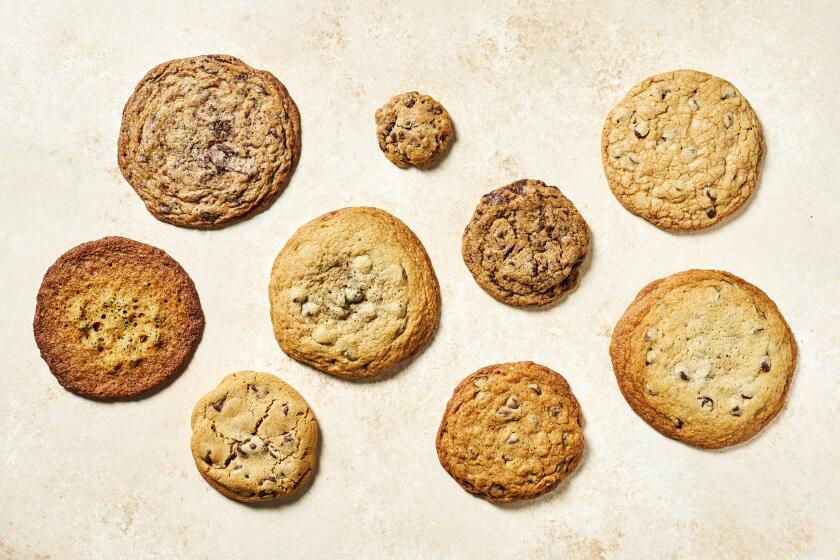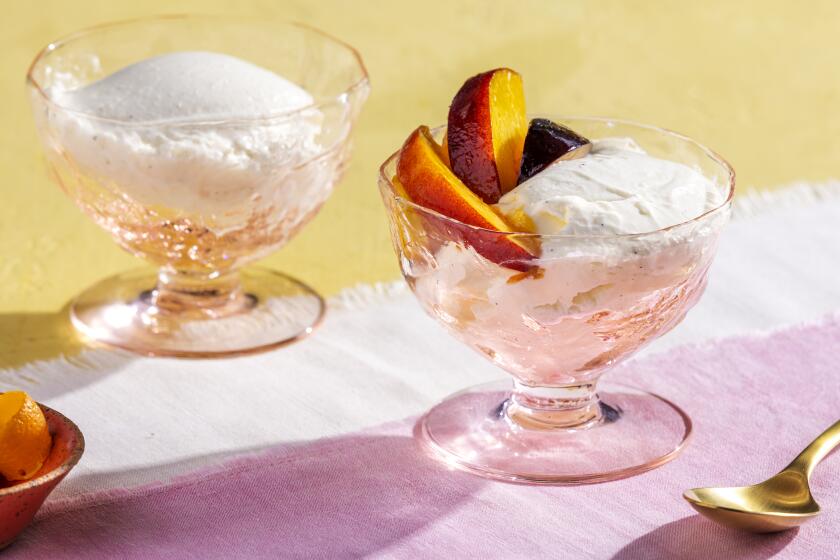Is this the best chocolate chip cookie recipe? Here’s what our experts say
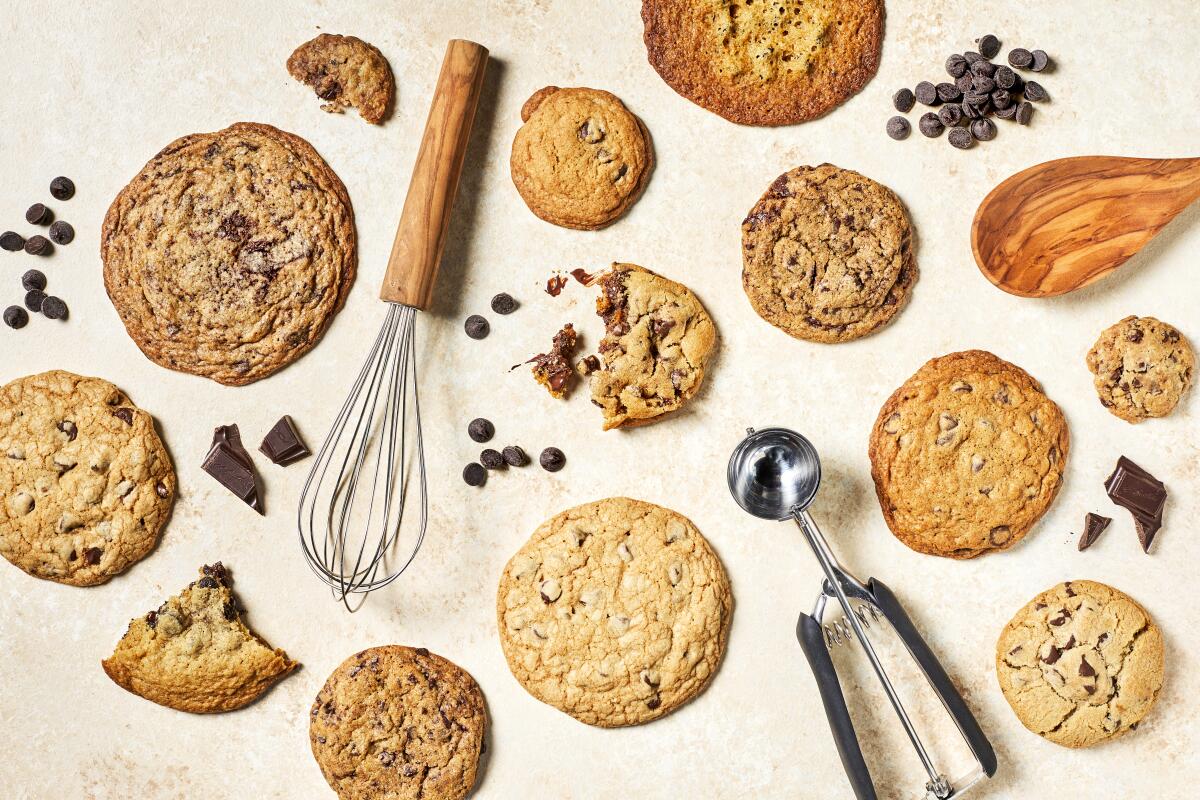
- Share via
A happy accident gave the world chocolate chip cookies. As the often-told story goes, it was 1939 when Ruth Wakefield, chef and co-owner of the Toll House Inn in Massachusetts, added chopped bits of Nestle chocolate to her cookie dough, thinking the pieces would melt and make a chocolate cookie. Instead the chocolate held its shape and became soft and creamy, providing a contrasting texture to the crunchy cookie. The recipe was published in a Boston newspaper, and the chocolate chip cookie soon became America’s favorite cookie.
Eighty-three years later, Americans still name the chocolate chip cookie as their favorite. A 2020 Better Homes & Gardens survey showed that 40% of respondents chose chocolate chip as their favored cookie (second was the peanut butter cookie). This year’s TasteAtlas ranking of North American cookies also shows chocolate chip as the favorite with its global audience.
But what is the best chocolate chip cookie recipe? Most people grow up using the recipe for Original Nestle Toll House Chocolate Chip Cookies, which appears on the yellow package of chocolate chips at the supermarket. It’s the standard that all others are judged by. But there’s more than one way to make a chocolate chip cookie. I tested nine reader favorites from our archives, hailing from bakeries and pastry chefs in Southern California, Washington and even London, often requested by readers through our historical Culinary SOS column. I sought to understand what makes one chocolate chip cookie different from another, the key success factors for a great chocolate chip cookie and if there is a single best recipe among them. More than 20 dozen cookies later, I have some answers.
Except for one vegan, gluten-free recipe, the ingredients for classic chocolate chip cookies were pretty similar across the board: all-purpose flour, granulated sugar, brown sugar, large eggs, butter, vanilla, salt, baking soda and chocolate. The same can be said about methodology: Cream the butter and sugars; add the eggs one at a time; add the vanilla; add the dry ingredients; and stir in the chocolate chips. Still, there were some distinct albeit subtle differences. That, I suppose, is where the art of baking takes over from the science.
For an overview of how the basic cookie ingredients and methods affect taste and texture, check out Noelle Carter’s “How to Make a Great Chocolate-Chip Cookie.” Those guidelines played out in some interesting ways in the nine recipes I tested.
As a point of reference, I baked a batch of Wakefield’s original Toll House Chocolate Chip Cookies. About 2 ½ inches in diameter, the cookies look like the Platonic form of a chocolate chip cookie: deep, golden brown, with a good balance of chips to cookie. They appear as though they may have been cut from a tube or come out of a grocery store package. They are small enough that you can eat a few, though they are rather sweet. They look like they will be crispy but are actually pleasantly cakey with a good chew and very little crunch. The chocolaty-ness was just right.
Some of the recipes I tested produced cookies that were very large; some were small. Some were chewy, and some were cakey. Some were distinctly gooey and others quite crunchy. Some were sweeter than others. Some cried for a bit more salt, and others had salt crystals sprinkled on top.
After each recipe was tested, a panel of experienced tasters weighed in. Among the tasters were Food columnist Lucas Kwan Peterson, reporter Stephanie Breijo and test kitchen manager Luciana Momesso. What everyone likes in a cookie might vary, but one showed up on every taster’s top-three list. The results are described below, loosely ordered from least to most favored. In a quest for the ultimate chocolate chip cookie, the question is, how do you like yours? (Tell us by filling out the chocolate chip cookie reader poll so we can come up with more recipes.)
On a hunt for the ultimate chocolate chip cookie, we tested 9 reader-requested recipes — chasing all our crispy-edged, chewy, crunchy, gooey, chocolaty dreams.
Erin McKenna’s Vegan Gluten-Free Chocolate Chip Cookie
• This cookie is for you if you like it: gluten-free, vegan, small, soft and chewy
Erin McKenna opened her first dietary-restrictions-friendly bakery, BabyCakes, in New York City in 2005 and Erin McKenna’s Bakery in L.A. on Larchmont in 2012. She shared her Vegan Gluten-Free Chocolate Chip Cookies recipe — a game changer for many with dietary restrictions — soon after opening her second L.A. location in Santa Monica. The cookies are bite-size — about 2 inches in diameter — and chewy; most would not guess that they are vegan or gluten-free, let alone both.
Clementine’s Chocolate Chip Cookie
• This cookie is for you if you like it: thin, chewy and buttery
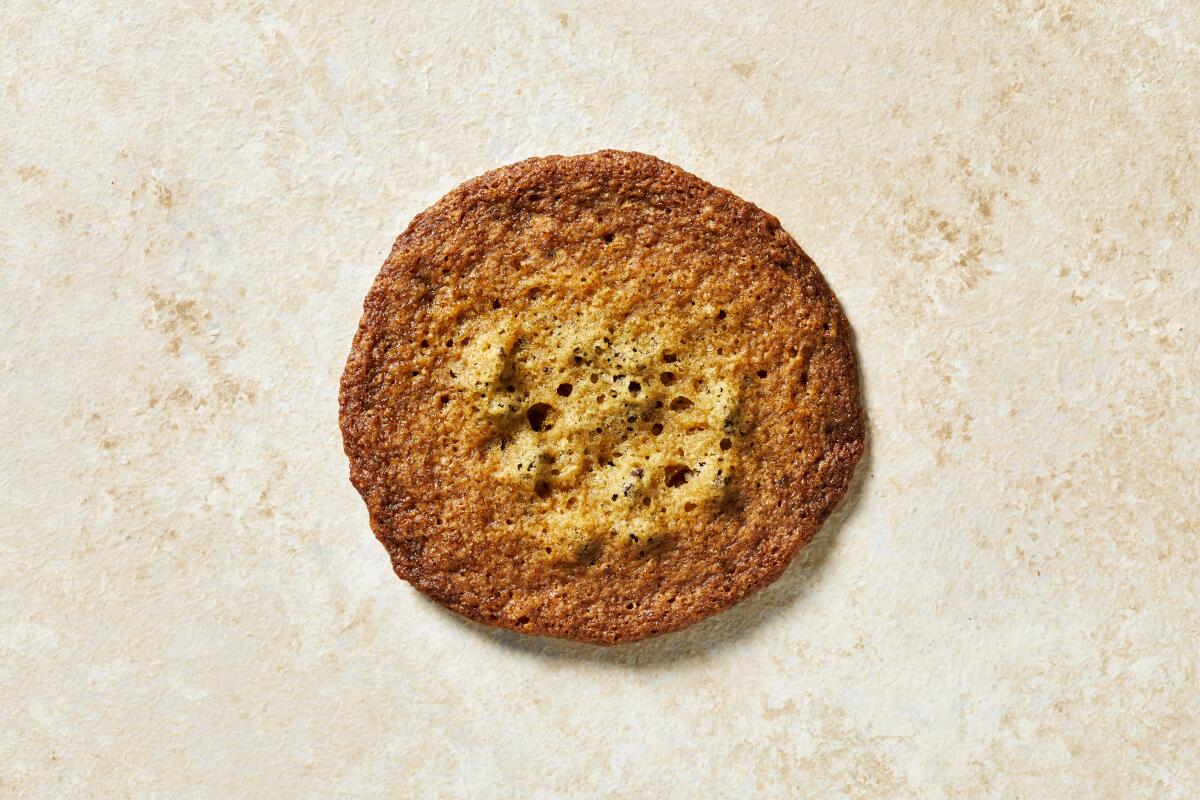
The recipe we published in 2003 from Annie Miler, owner of Clementine in Century City, first stood out because cake flour is swapped in for some of the AP flour. These also baked up the thinnest of the cookies I tested. They looked as if they would be very crisp since they spread to 4 inches in diameter and less than ¼ inch thick in the baking. (I attributed the spread to the cake flour, which has less protein and gluten than AP flour — cookies made with it usually won’t hold as firm a structure as those made only with AP flour.) The cookie is so thin that you expect it to shatter when you bite into it. Instead, you get a mouthful of chewy, buttery cookie, with the chips concentrated toward the center of the cookie.
Gail’s Artisan Bakery’s Chocolate Chip Cookie
• This cookie is for you if you like it: thick, cakey, gooey in the center and with crispy edges
All but one of the recipes call for both white granulated sugar and brown sugar and, in general, use more brown sugar than granulated. Granulated sugar will produce a flatter, crispier cookie, while brown sugar will lead to a moister, chewier cookie. One exception: Gail’s Artisan Bakery in London uses powdered sugar rather than granulated sugar in a recipe we published in 2013. The powdered sugar absorbs more moisture from the other ingredients and can lead to an extra-tender texture, which was evident in the final product.
At 5 inches, the cookies from Gail’s Artisan Bakery are large. Thick, with dark, crispy edges, the cookie’s color transitions to lighter and more golden toward the center, which is cakey and gooey with chocolate. The salty-sweet-chocolaty balance is just right. Powdered sugar rather than granulated may account for those crispy edges. Feel free to make smaller cookies — and remember that the smaller size may reduce the baking time by a few minutes.
Joan’s on Third‘s Giant Chocolate Chip Cookie
• This cookie is for you if you like it: big, soft, cakey, gooey in the center and on the sweet side
Also clocking in at a full 5 inches in diameter, the Giant Chocolate Chip Cookies from a Joan’s on Third recipe published in 2012 are cakey behemoths that will surely delight schoolchildren. Chocolaty and gooey in the center, they were a little too sweet and chocolaty for most of our taste testers. Feel free to make these smaller; they still bake up beautifully and hold their thickness. And don’t let the estimated hour and 15 minutes it takes to make them deter you — that includes 40 minutes of bake time.
Eggs add moisture and make for cakier cookies. Most of the recipes we tested used 2 large eggs, and the cookies were moist and chewy. The Joan’s on Third cookies call for extra-large eggs and, indeed, were cakier and thicker than the others. By contrast, Oven Spoonful (see below) uses 1 whole egg and 1 yolk, which resulted in a cookie that one taster described as a cross between a cookie and a brownie. Joan’s on Third’s recipe also used more than twice as much brown sugar as granulated, further adding to the cookies’ moistness.
Oven Spoonful’s Chocolate Chip Cookie
• This cookie is for you if you like it: big, on the sweet side, extra chocolaty, chewy on the inside and crackly on top
Dense, sweet and chocolaty, the chocolate chip cookies from now-closed cafe Oven Spoonful in Port Angeles, Wash., have great crunch (with chewy middles) and a beautiful, crackly top. Portioned as specified, these cookies are a whopping 6 inches each — and the recipe makes only 10 of them. Go ahead and reduce the portion size by half or more to elicit more cookies from your efforts. The cookies do not suffer for the smaller size — and you just might be able to eat a whole one without blowing your calorie budget for the week.
Marcy Goldman’s Commercial-Style Chocolate Chip Cookie
• This cookie is for you if you like it: thick, on the sweet side, extra chocolaty, chewy and with crispy edges
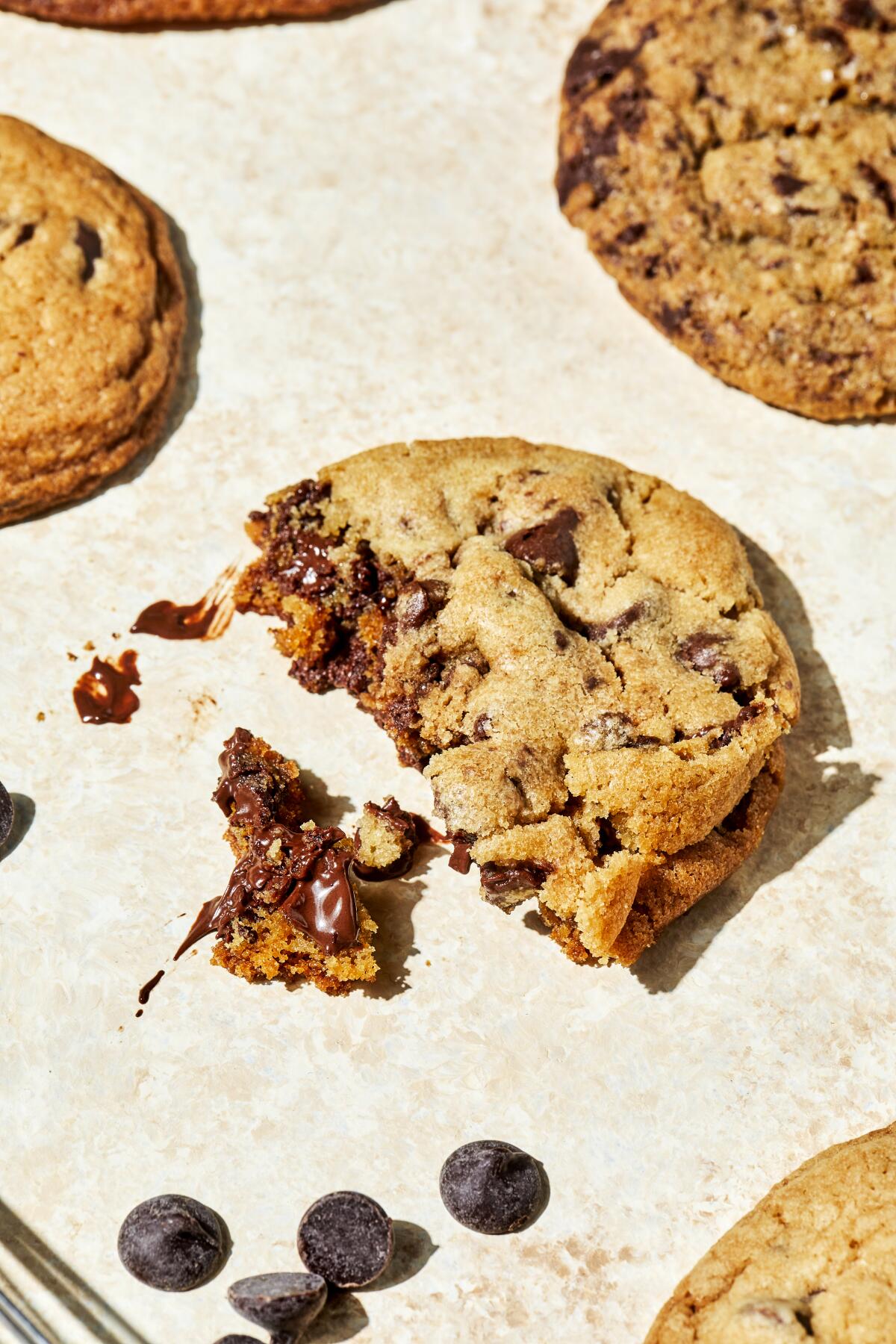
Of the nine recipes I tested, the one most similar to “the original” is Marcy Goldman’s Commercial-Style Chocolate Chip Cookies, published in 2000. A rather terse and straightforward recipe, the technique is clearly articulated with few details. The dough was very easy to work with and, like Wakefield’s, required no chilling before scooping and baking. The cookies are about 3 inches in diameter if made using rounds “slightly larger than golf balls.” But they are very sweet and very chocolaty — more than our taste testers preferred. Overall, these cookies are crisp on the edges, crumbly on the outside, chewy on the inside and almost cakey in the middle. They are even sweeter than Wakefield’s and more chocolaty, but the texture is a bit more complex.
Elia’s Chocolate Chip Cookie
• This cookie is for you if you like it: chewy, thin, buttery, with chocolate chunks and crispy edges
Ranked among our taste testers’ top three was Elia’s Chocolate Chip Cookies recipe from Rubies + Diamonds in Hollywood, which we published in 2016. The cookies are particularly attractive, owing to hand-chopping the chocolate. While the larger chunks retain their shape, the smaller bits melt into the dough and add a different dimension of chocolaty-ness, as well as visual appeal. The artisanal look is an indicator of the deliciousness. On the thinner side, the cookies are crisp on the edges and chewy throughout. The flavors are well balanced — sweet and chocolaty without being too much of either. It’s a real crowd-pleaser of a cookie.
Amy Scattergood’s Chocolate Chip Cookie
• This cookie is for you if you like it: not too sweet, chewy, with crispy edges and oatmeal
Half of the recipes call for chilling the dough, and half do not. One recipe from 2010, adapted from the cookies that former Food Editor Amy Scattergood remembers her mother making, leaves the decision of whether to chill or not to chill to the recipe user. We tried it both ways for this cookie and saw no discernible difference in the result. In fact, while not chilling the dough impacted the shape of those cookies whose recipes called for it, chilling did not seem to affect those that did not call for it — the cookies spread the same whether the dough was chilled prior to baking or not.
Scattergood’s mother was a home ec instructor, and her chocolate chip cookies include oats for texture and flavor (OK, and for some nutritional value too). They are about 4 inches in diameter, chewy with crispy edges and, yes, lots of texture. Not too sweet, not too oat-y and with just the right amount of chocolate, this is a very “grown-up” cookie. It received high marks from our tasting panel.
Sycamore Kitchen’s Chocolate Chip Rye Cookie
• This cookie is for you if you like it: not too sweet, thick, chewy and a little salty
Most of the recipes called for AP flour exclusively. The one we published in 2016 from Karen Hatfield, co-owner of Los Angeles’ Sycamore Kitchen, uses equal parts rye flour and AP flour.
Interestingly, while rye flour is less glutinous, and thus less structure-protecting, Sycamore Kitchen’s recipe did not produce a thin cookie. Rather, it was sturdy, thick and chewy. The recipe did, however, use a total of 2 cups of flour, whereas Clementine’s uses only 1 ¼ cup of flour to the same ¾ cup of butter in both recipes. So it could be the additional flour in the Sycamore cookie that gives it more structure — and the higher proportion of fat is responsible for the Clementine cookie’s spread. But unlike the others, Sycamore Kitchen’s recipe used baking powder, which helps with the rise, in addition to baking soda. This may have contributed to the cookie’s sound structure.
All of our taste testers ranked Sycamore Kitchen’s Chocolate Chip Rye Cookie one of their top three favorites of the bunch. The rye flour and some ground caraway give it a darker color and more complex flavor. Overall, this is a flavorful, chewy, well-balanced cookie (bonus points for a sprinkle of salt).
Baking notes
The type of chocolate/chocolate chips was an interesting point of differentiation. The Oven Spoonful and Commercial-Style recipes merely called for “chocolate chips,” leaving it to the user to decide how sweet and how chocolaty they want their cookies. Amy Scattergood’s mom’s recipe specified semisweet chocolate chips, and Clementine’s called for pastilles (flat, lozenge-style pieces). Other recipes stipulate coarsely chopped chocolate and recommend cocoa content percentages, which range from 60% to 71%. (Semisweet chocolate can range from 35% to 65% cocoa. Most chips clock in around 50%; Nestle semisweet morsels are made with 66% cocoa solids; Nestle dark chocolate morsels are made with 53% cacao.) In general, a higher cocoa-solid content implies less sugar in the chocolate. A few, like Elia’s, specified a particular brand as well.
Other than chilling the dough, the other methodological variant of note was baking temperature: Some call for a relatively cooler 325-degree oven, some for a very hot 375-degree oven, but most bake at 350.
The type of flour can impact the structure and how well a cookie holds its shape once it has risen and the butter melts in the baking process. Brown sugar will make a cookie chewier, white granulated sugar will make it crispier. Chilling dough prior to baking can help cookies retain their shape. More eggs will make a cookie cakier; more yolks than whites will make for a chewier, creamier cookie, while more whites than yolks will make a cookie crispier. These are some of the variables that contribute to such different results from recipes that use essentially the same ingredients and methodology.
In the end, of these nine recipes, none of our taste testers landed on the same one as THE BEST. What’s most important: Balancing the sweet, salty and chocolaty flavors is crucial to a great chocolate chip cookie. The search for the perfect recipe continues. And we want to hear from you! What do you think makes the perfect chocolate chip cookie? Answer in the poll below.
Stephanie Breijo, Lucas Kwan Peterson, Luciana Momesso and Micah Fluellen contributed to this story.
More to Read
Eat your way across L.A.
Get our weekly Tasting Notes newsletter for reviews, news and more.
You may occasionally receive promotional content from the Los Angeles Times.

